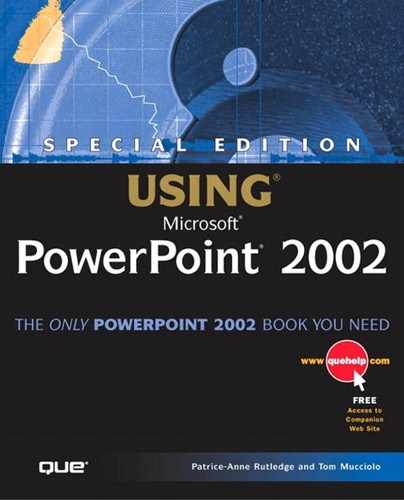Understanding Macros
Macros are programs that automatically execute a series of functions in PowerPoint to achieve a particular goal. You can easily create a macro without programming by recording a series of tasks that you would otherwise perform yourself. You can record any number of steps in a task, from applying a format to running a slideshow, and choose from a variety of ways to run the macro in the future. Macros are simple to create, easy to run, and can be used throughout an office to standardize the development process, as well as the appearance of presentations. In addition to recording macros, you can create them as Visual Basic for Applications programs.
Note
Macros use Visual Basic for Applications (VBA) as their programming language. Don't worry, however; recording, editing, and using macros requires little or no knowledge of VBA. You can improve your ability to edit and troubleshoot your macros by becoming acquainted with VBA, but many (if not most) users don't interact directly with VBA to create, change, or run their macros.
The applications found in Microsoft Office XP contain so many tools and menu commands that perform such a wide variety of seemingly automatic tasks, it might seem unnecessary for you to ever build your own macros. How could PowerPoint possibly work faster? What tasks require too many steps to be convenient?
Your first impression may be that the software makes it so simple and quick to develop a great presentation that further automation isn't needed. If you spend a great deal of time with PowerPoint, however, or if the presentations you create have many common elements, you'll no doubt benefit from this chapter as you find ways to make repeated tasks simpler, faster, and, most importantly, more consistent in their outcome.
Perhaps you're stumped—you can't imagine how you could use macros to speed up or simplify your use of PowerPoint. Check the following list for some ideas:
Getting started Your macros can be run as soon as your toolbars appear and the first slide is onscreen. Create a macro to apply a design template and create a series of standard slides for your presentation. After that, all you have to do is add any extra slides that aren't part of your standard presentation, and enter your content. Much of your content entry also can be done with macros.
Building an outline If you create the same sales or productivity presentations every quarter, don't reinvent the wheel each time, and don't reuse your old presentations and risk overwriting them or leaving old data behind. Create a macro that builds the basic presentation, from choosing slide layouts to entering slide titles. Then, all you have to do is enter the new data and your presentation is complete.
Making changes to the master Create a series of macros that insert a logo on your slide master, add a slogan to your title master, or change the font of your text on all masters. Any changes that you find yourself making on all or most of your presentations can be automated with macros.
Setting up a slide If your slide layout needs are not met by any of the installed layouts, simply create a macro that inserts chart objects, tables, text objects, and graphics. The macro can include your placement and sizing of these objects, so that when the macro is run, all you need to do is fill in the blanks—double-click and insert the chart data, edit the organization chart, or type your text—and the layout is done for you.
Inserting hyperlinks Do all your presentations have links to your company Web site or an internal database? Create a macro that inserts the hyperlink. This includes choosing the linked site or file and entering the text or graphic that serves as the link.
Building an organization chart With the exception of the names of new or relocated people, the organization charts of most companies don't vary from presentation to presentation. Rather than having to manually copy and paste a chart from a previous presentation, you can record a macro that inserts your company's completed organization chart. After running the macro, all you have to do is edit the names and titles to reflect changes in the roster since you recorded the macro. If, over time, the changes are significant, you can simply edit the source chart so that when the macro inserts it, the majority of the needed changes have already been made.
Running a slideshow Rather than make your audience sit through the process of opening the presentation and starting the show, record a macro that can be run as soon as you open PowerPoint. You'll have rehearsed your show and set any automatic slide timings before recording the macro, so that all the macro needs to do is start the show.
